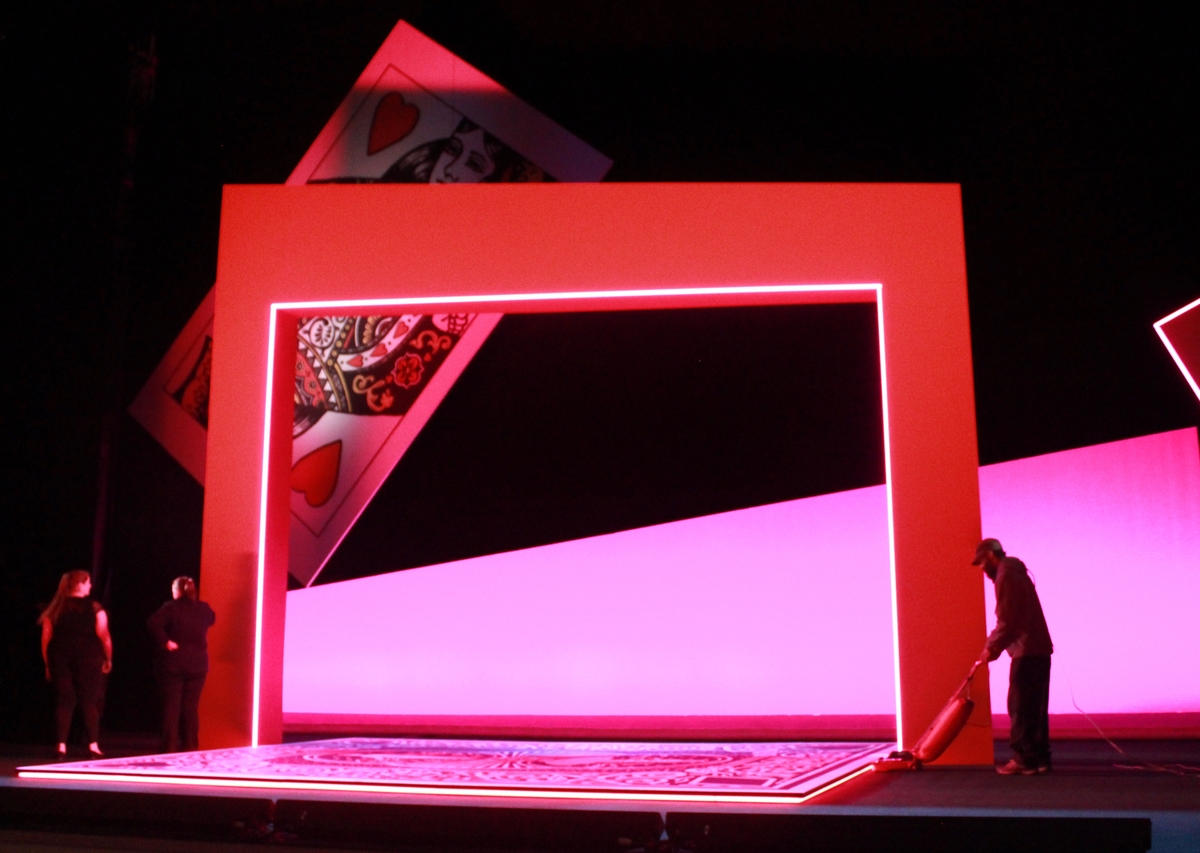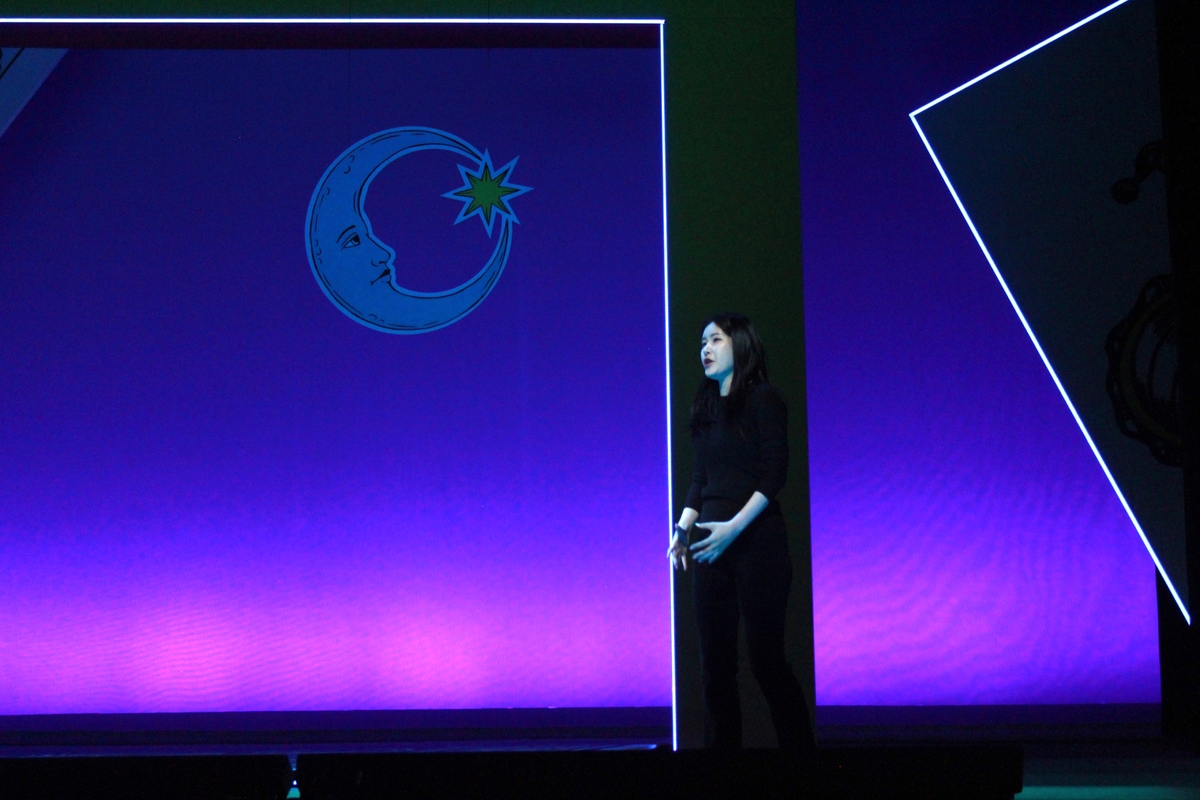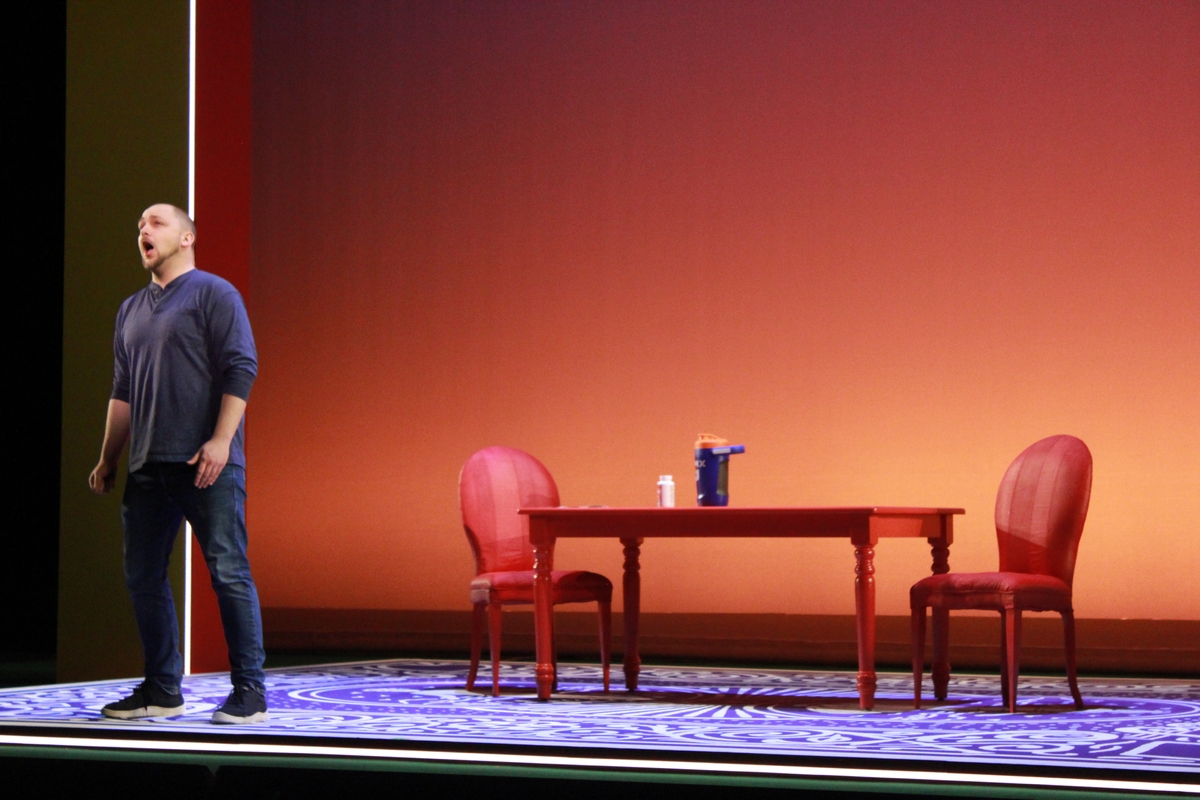
Brian Slattery Photo
Suzu Sakai on the Shubert set she designed.
A member of the stage crew was doing some last-minute cleanup of the set at the Shubert, in preparation for a rehearsal of Yale Opera’s The Rake’s Progress, the opera by Igor Stravinsky set to run at the venerable College Street theatre Feb. 17 and 18. At first glance, it may have looked like he was vacuuming a vast Persian rug. A second glance, however, might show the design on the floor for what it really is: the back of an enormous playing card. More than just an arresting visual pattern, the scintillating floor is part of a set design decision that, for the opera’s director, was the key to opening up Stravinsky’s work to better connect with audiences.
As Yale Opera and the Shubert bill it, The Rake’s Progress is “a classic Faustian tale that warns us to be careful what we wish for. Stravinsky’s only full-length opera depicts the misadventures of Tom Rakewell, who, lured with a promised inheritance into unknowingly making a deal with the devil, leaves his fiancée, Anne Trulove, in the country in search of the excitement of London. Tom’s mysterious new servant, Nick Shadow, is only too happy to oblige Tom on a path of debauchery.” The libretto is written by poets W.H. Auden and Chester Kallman and follows more or less the story laid out in William Hogarth’s series of paintings of the same name.
As operas go, however, The Rake’s Progress is relatively new. The title may make it sound old, and yes, Hogarth’s paintings are from the 18th century. But the English-language opera is from 1951, composed when Stravinsky was living in Hollywood, where he’d been for about a decade. The opera is thus very much a product of the modern world, and Yale Opera’s production of it follows suit, placing it not just in the mid-20th century, but, if anywhere specific, mid-20th century Las Vegas. Where else?

Brian Slattery Photos
In talking with director Danilo Gambini about how to stage The Rake’s Progress, “both of us veered away from traditional opera design,” said set designer Suzu Sakai. “I see it as a play within a play, a morality piece. There’s the Devil. There are a lot of characters that don’t make sense.” Characters freeze in time, and can stop time. “It’s a very whimsical piece, so I wanted to reflect that in the design.”
Sakai’s set decisions turned out to lay the groundwork for the production’s organizing principles. Whenever dealing with a new piece, “I always need the key to unlock it. It’s always a concept,” Gambini said. He and Sakai went through “a lot of ideas” and “Suzu was the one who underlined playing cards, because they are woven into the play.” For Gambini, that idea “unlocked” the opera. “We started figuring out ways it would extrapolate into everything,” he said.
The deck of cards makes an immediate connection to the plot, as “Tom is putting his life on the line when he gambles with the Devil,” Sakai said — especially in a pivotal graveyard scene, when “Tom finally realizes his mistakes.” But in general, as the opera follows Tom, “it is all about his choices, as a person who is lazy,” and we all know what the Devil does with idle hands. Sakai was also inspired by tarot cards, which have an intertwined history with playing cards but lean harder into ideas about destiny and fate.
Together, Sakai and Gambini “took what we thought was the design for the show and distilled it down into what we thought were the elemental pieces,” Sakai said. Gambini wanted to make sure everything was “bold and big,” he said. “And whimsical — and asymmetrical.”
The yellow frame on the stage of the Shubert hearkens to the play within a play in the piece, and lets the characters have an inside and an outside space on the stage. The colors come from playing cards — and from “us playing around,” Sakai said.
The frame’s forced perspective came about because “Danilo didn’t want any symmetry in the set,” Sakai said, which led to her “playing around with angles and the placement of everything.” The giant playing cards, with designs drawn by Sakai herself, can move; a giant sword and a sun and moon from tarot cards can also “fly in.” The slanted border in the background also moves. “It almost looks like a guillotine, so I was pretty happy about that,” Sakai said.
The idea of keeping things asymmetrical is drawn from theater theorist Eugenio Barba, who said that “humans look for symmetry, as an impulse, but when we find it, we look elsewhere,” Gambini said. “We want to find it and resolve it. So whenever there’s symmetry, we don’t pay attention, because it’s resolved. So the idea is to not resolve the scene, so then we keep the audience engaged and their attention engaged. Specifically in opera, when we need the ears to be activated, because the ears are the way to the heart.” Keeping the visuals activated helps audiences listen harder.

Sakai’s and Gambini’s ideas came to life even in tech rehearsal, where the singers (not yet in costume) performed in the world of the set. Right away, the set, in turning away from realism and toward bigger, bolder gestures, showed its ability to enhance the mood, giving the audience details about the direction of the scene and the internal emotions of the character.

And in the next rehearsal scene, the mood changed completely, the colors flipping from cool to hot, as the character detailed, in song, his dissatisfaction with his current situation. The libretto gave him a single line to button up the turmoil in the music. “I wish I could be happier,” the singer said, clearly and plainly. The playing card beneath his feet offered a silent yet overwhelming commentary. If the character just looked around, he would see the gamble he was taking.
Yale Opera’s production of The Rake’s Progress runs at the Shubert Theatre, 247 College St., Feb. 17 and 18. Visit the Shubert’s website for tickets and more information.